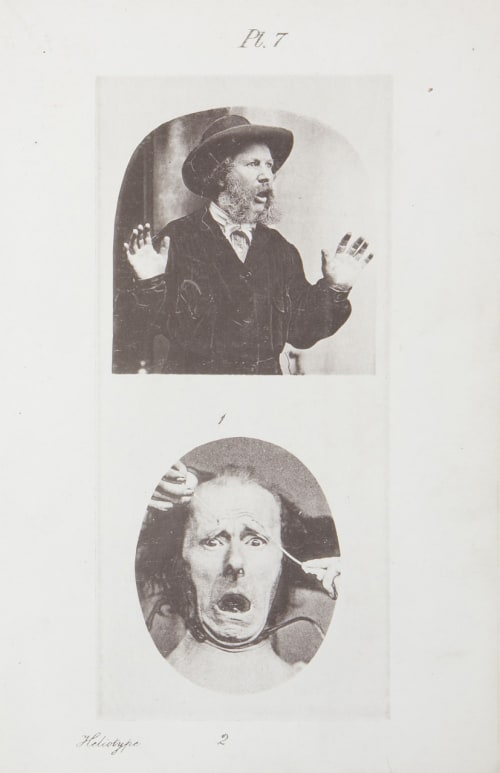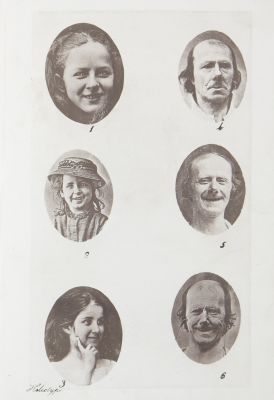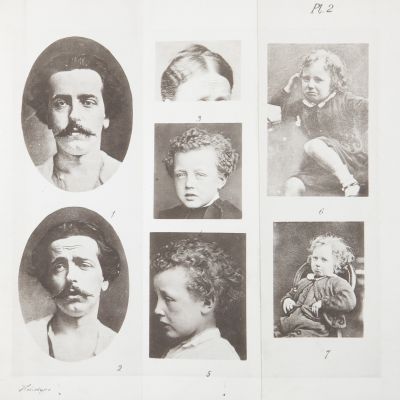
Title
Pl. 7Artist
Rejlander, Oscar G. (British, 1870-1875)Publication
The Expression of the Emotions in Man and AnimalsDate
1872Process
HeliotypeAtelier
Ernest EdwardsImage Size
19 x 12 cm
Photographic technology improved rapidly during the latter half of the 1800s. Once it became capable of taking pictures faster than what the naked eye could see, it began to affect measures of scientific integrity. (Phillip Prodger – Darwin’s Camera) Darwin incorporated the photographic illustrations in this volume to support his key point that man’s facial muscles had evolved from the faces of monkeys, and were not divinely created as a unique means of self-expression. He commissioned Oscar Gustave Rejlander for some of the images, others he borrowed from Duchenne de Boulogne and from Herr Kinderman from Hamburg and Dr. Wallich. The plates were among the first successful published examples of heliotypes (collotypes) as invented by Ernst Edwards and a significant link in the evolution of visual culture at the intersection of art, science and psychology. (Maria Popova) Darwin’s concern was to show how human expressions link human movements with emotional states, and are genetically determined and derive from purposeful animal actions. The Truthful Lens
Oscar Gustave Rejlander was born in Stockholm in 1813 and emigrated to England in the 1830s. In 1853 Rejlander, eager to learn the wet-collodion process of photography in just one day, paid a hurried visit to a photographer’s studio in London. As implied in the name, the wet-plate glass negative had to be used while the collodion was still damp, and the process was not easy to master. Nevertheless, after a three-and-a-half-hour crash course in photography, Rejlander was turned loose. Rejlander lived in the industrial town of Wolverhampton, England, and specialized in genre scenes of domestic life, using his friends and neighbors as models. Believing that photography would make painters more careful draftsmen, he earned a modest living making photographic studies for artists, probably including Sir Lawrence Alma Tadema. Rejlander is best known for his combination prints, elaborate genre and allegorical scenes made from multiple negatives carefully joined, printed on a single large sheet of paper, and then re photographed to create a seamless image. (source: The Getty Museum)
Notes: Man in hat is Oscar Rejlander who was commissioned by Darwin to create these photographs. The heliotypes were made at Ernest Edwards new Edwards Heliotype Plant using a process patented by Edwards.
Reproduced / Exhibited
Thomas, Ann, Marta Braun, Mimi Cazort, Martin Kemp, John P. MacElhone, and Larry J. Schaaf. Beauty of Another Order. New Haven a. London: Yale University Press, 1997. P. 135 (plate 6)
Goldschmidt, Lucien, and Weston J. Naef. The Truthful Lens: A Survey of the Photographically Illustrated Book, 1844-1914. New York: The Grolier club, 1980. no. 23 (self-portrait) no. 90
Rosenblum, Naomi. A World History of Photography. New York: Abbeville Press, 2008. no. 78, 79.
Pollack, P. The Picture History of Photography: From the Earliest Beginnings to the Present Day. New York: Harry N. Abrams, Inc, 1998.p. 178
Jones, Edgar Y. Father of Art Photography: O.g. Rejlander, 1813-1875. Greenwich, Conn: New York Graphic Society, 1973. p. 106
Gernsheim, Helmut. The History of Photography: The Age of Collodion. London: Thames and Hudson, 1989. p. 47
References
[1] Philip Prodger: Darwin’s Camera, Oxford University Press, Oxford, 2009 How Darwin’s Photographic Studies of Human Emotions Changed Visual Culture https://www.themarginalian.org/2011/11/11/darwins-camera/
[2] Goldschmidt Lucien Weston J Naef and Grolier Club. 1980. The Truthful Lens : A Survey of the Photographically Illustrated Book 1844-1914. 1st ed. New York: Grolier Club


